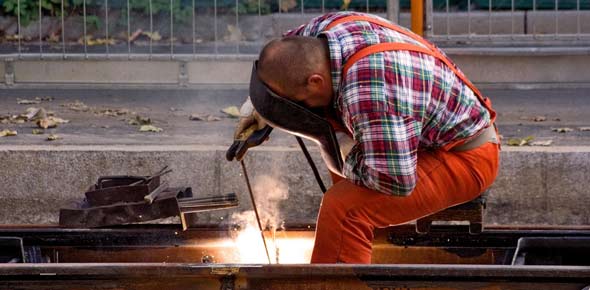CSWIP 3.1

Revision Questions Multi Choice
- 1.
- Applying preheat when welding carbon manganese steel is normally done to avoid:
- A.
A) Slag inclusions
- B.
B) Hydrogen cracking
- C.
C) Lack of sidewall fusion
- D.
D) Porosity
Correct Answer
B. B) Hydrogen crackingExplanation
Preheating when welding carbon manganese steel is typically done to prevent hydrogen cracking. This is because preheating helps to reduce the cooling rate of the weld, which in turn reduces the risk of hydrogen becoming trapped in the weld and causing cracking. Hydrogen cracking can occur when hydrogen diffuses into the weld metal and becomes trapped as it solidifies, leading to the formation of cracks. By preheating the steel, the cooling rate is slowed down, allowing hydrogen to escape and reducing the likelihood of cracking.Rate this question:
- 2.
Which of following mechanical properties of a weld in carbon manganese steel is most affected if the heat input per unit length of weld is excessively high?
- A.
A) Elongation
- B.
B) Tensile strength
- C.
C) Hardness
- D.
D) Toughness
Correct Answer
D. D) ToughnessExplanation
If the heat input per unit length of weld is excessively high in carbon manganese steel, it can lead to a decrease in toughness. High heat input can cause the formation of coarse grains in the weld zone, which can result in reduced toughness. Coarse grains are more prone to cracking and can lead to brittle behavior, reducing the material's ability to absorb energy and resist fracture. Therefore, toughness is the mechanical property most affected by excessively high heat input in this scenario.Rate this question:
-
- 3.
You observe centerline cracking a weld that as been made one of five work stations each making similar components. The first action to take is:
- A.
A) Impound all welding consumables
- B.
B) Report the occurrence to high authority
- C.
C) Stop all welding
- D.
D) Call for full NDT checks
Correct Answer
B. B) Report the occurrence to high authorityExplanation
The correct answer is b) Report the occurrence to high authority. This is the first action to take because centerline cracking in a weld is a serious defect that can compromise the structural integrity of the components. Reporting the occurrence to high authority ensures that the issue is brought to the attention of those who have the power to address it and take appropriate actions to prevent further occurrences. Impounding all welding consumables, stopping all welding, and calling for full NDT checks may be necessary steps to investigate and rectify the issue, but reporting it to high authority is the initial action to initiate the process.Rate this question:
-
- 4.
Which of the following defects is unlikely to be found by visual inspection.
- A.
A) Linear misalignment
- B.
Undercut
- C.
Overlap
- D.
D) Linear slag inclusion
Correct Answer
D. D) Linear slag inclusionExplanation
Linear slag inclusion is unlikely to be found by visual inspection because it is a defect that occurs within the weld and is not easily visible on the surface. Slag inclusions are non-metallic materials trapped in the weld metal or between the weld and base metal, and they can be difficult to detect without using non-destructive testing methods such as radiography or ultrasonic testing. Visual inspection alone may not be sufficient to identify linear slag inclusions, making it an unlikely defect to be found through this method.Rate this question:
-
- 5.
Which of the following welding processes uses a resisitive heating system to achieve weld metal deposition.
- A.
A) Manual metal arc welding
- B.
B) Submerged-arc welding
- C.
C) Electro slag welding
- D.
D) Resistance spot welding
Correct Answer
D. D) Resistance spot weldingExplanation
Resistance spot welding uses a resistive heating system to achieve weld metal deposition. In this process, two metal pieces are pressed together and an electric current is passed through them. The resistance of the metal generates heat, which melts the metal at the contact points. As the current continues to flow, the molten metal solidifies, forming a weld. This process is commonly used for joining thin metal sheets or wire mesh, and it is often used in automotive manufacturing and construction industries.Rate this question:
-
Quiz Review Timeline +
Our quizzes are rigorously reviewed, monitored and continuously updated by our expert board to maintain accuracy, relevance, and timeliness.
-
Current Version
-
Mar 21, 2023Quiz Edited by
ProProfs Editorial Team -
Oct 18, 2012Quiz Created by
John
- ACA Quizzes
- ACCA Quizzes
- ACE Quizzes
- BCBA Quizzes
- CCP Quizzes
- CDC Quizzes
- CEH Quizzes
- CISA Quizzes
- CISCO Quizzes
- CISSP Quizzes
- CompTIA Quizzes
- CPA Quizzes
- CPAT Quizzes
- CPFA Quizzes
- CPP Quizzes
- CPT Quizzes
- CSA Quizzes
- CSET Quizzes
- CST Quizzes
- FTCE Quizzes
- HIPAA Quizzes
- IAHCSMM Quizzes
- ISTQB Quizzes
- LEED Ga Quizzes
- MBLEx Quizzes
- NCIDQ Quizzes


